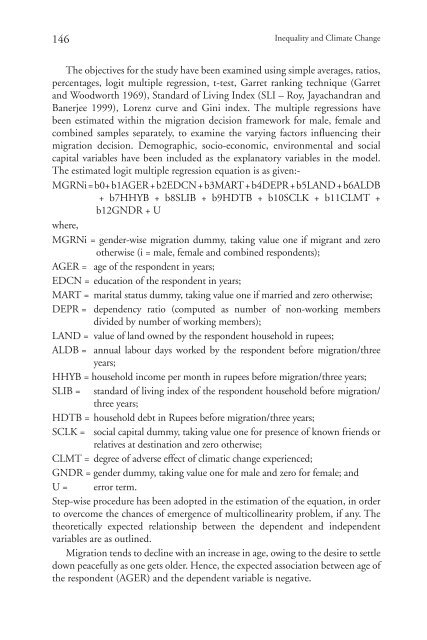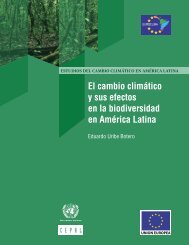Inequality and Climate Change Inégalité et changement climatique
Inequality
Inequality
Create successful ePaper yourself
Turn your PDF publications into a flip-book with our unique Google optimized e-Paper software.
146<br />
<strong>Inequality</strong> <strong>and</strong> <strong>Climate</strong> <strong>Change</strong><br />
The objectives for the study have been examined using simple averages, ratios,<br />
percentages, logit multiple regression, t-test, Garr<strong>et</strong> ranking technique (Garr<strong>et</strong><br />
<strong>and</strong> Woodworth 1969), St<strong>and</strong>ard of Living Index (SLI – Roy, Jayach<strong>and</strong>ran <strong>and</strong><br />
Banerjee 1999), Lorenz curve <strong>and</strong> Gini index. The multiple regressions have<br />
been estimated within the migration decision framework for male, female <strong>and</strong><br />
combined samples separately, to examine the varying factors influencing their<br />
migration decision. Demographic, socio-economic, environmental <strong>and</strong> social<br />
capital variables have been included as the explanatory variables in the model.<br />
The estimated logit multiple regression equation is as given:-<br />
MGRNi = b0+ b1AGER + b2EDCN + b3MART + b4DEPR + b5LAND + b6ALDB<br />
+ b7HHYB + b8SLIB + b9HDTB + b10SCLK + b11CLMT +<br />
b12GNDR + U<br />
where,<br />
MGRNi = gender-wise migration dummy, taking value one if migrant <strong>and</strong> zero<br />
otherwise (i = male, female <strong>and</strong> combined respondents);<br />
AGER = age of the respondent in years;<br />
EDCN = education of the respondent in years;<br />
MART = marital status dummy, taking value one if married <strong>and</strong> zero otherwise;<br />
DEPR = dependency ratio (computed as number of non-working members<br />
divided by number of working members);<br />
LAND = value of l<strong>and</strong> owned by the respondent household in rupees;<br />
ALDB = annual labour days worked by the respondent before migration/three<br />
years;<br />
HHYB = household income per month in rupees before migration/three years;<br />
SLIB = st<strong>and</strong>ard of living index of the respondent household before migration/<br />
three years;<br />
HDTB = household debt in Rupees before migration/three years;<br />
SCLK = social capital dummy, taking value one for presence of known friends or<br />
relatives at destination <strong>and</strong> zero otherwise;<br />
CLMT = degree of adverse effect of climatic change experienced;<br />
GNDR = gender dummy, taking value one for male <strong>and</strong> zero for female; <strong>and</strong><br />
U = error term.<br />
Step-wise procedure has been adopted in the estimation of the equation, in order<br />
to overcome the chances of emergence of multicollinearity problem, if any. The<br />
theor<strong>et</strong>ically expected relationship b<strong>et</strong>ween the dependent <strong>and</strong> independent<br />
variables are as outlined.<br />
Migration tends to decline with an increase in age, owing to the desire to s<strong>et</strong>tle<br />
down peacefully as one g<strong>et</strong>s older. Hence, the expected association b<strong>et</strong>ween age of<br />
the respondent (AGER) <strong>and</strong> the dependent variable is negative.





